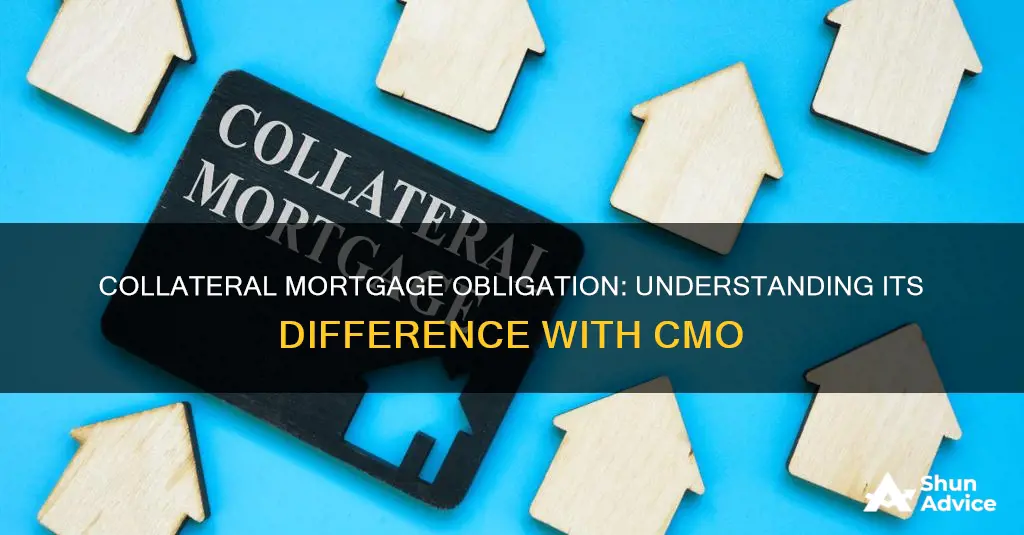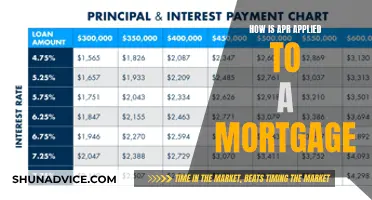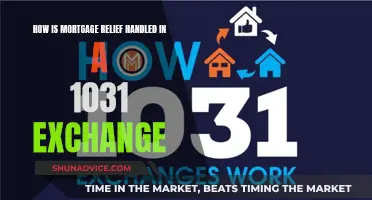
Collateralized Mortgage Obligation (CMO) is a type of mortgage-backed security that involves pooling mortgages into a special entity and selling them as an investment. These are organised by maturity and risk profiles, with investors receiving payments based on predetermined rules. CMOs played a significant role in the 2008 financial crisis and are sensitive to interest rate changes and economic conditions. In contrast, Mortgage-Backed Securities (MBS) are a broader category of asset-backed securities, representing the interest in a pool of mortgage loans. MBS pass through all principal and interest to investors, while CMO investors are paid differently, based on the tranches of risk they invest in.
| Characteristics | Values |
|---|---|
| Definition | A collateralized mortgage obligation (CMO) is a type of mortgage-backed security that contains a pool of mortgages bundled together and sold as an investment. |
| Type of security | CMO is a type of MBS (mortgage-backed security) |
| Creation | CMOs were first created in 1983 by the investment banks Salomon Brothers and First Boston for the U.S. mortgage liquidity provider Freddie Mac. |
| Investors | Investors in CMOs include banks, hedge funds, insurance companies, pension funds, mutual funds, government agencies, and most recently central banks. |
| Risk | CMOs are sensitive to interest rate changes and changes in economic conditions, such as foreclosure rates, refinance rates, and the rates at which properties are sold. |
| Payment | CMOs distribute principal and interest payments to their investors based on predetermined rules and agreements. |
| Structure | CMOs consist of several tranches, or groups of mortgages, organized by their risk profiles. |
| Tranches | Each tranche has a different maturity date and size, and the way investors are paid differs from traditional MBS. |
What You'll Learn

CMOs are a type of mortgage-backed security
CMOs, or collateralized mortgage obligations, are a type of mortgage-backed security. They are a complex form of debt security that allows investors to profit from the mortgage industry without directly buying or selling home loans. CMOs are created when mortgages are pooled together and packaged as a single security, which is then sold to investors. These mortgage pools are known as collateral, and they consist of mortgages with similar characteristics, such as credit score or loan amount. The CMO structure is designed to meet investor needs by directing the payments of principal and interest from the collateral pool to different types and maturities of securities.
CMOs are divided into categories, or tranches, based on risk and maturity dates. Each tranche has a different maturity date, size, and level of risk. The tranches are fractions or slices of the mortgage pool and the income it produces, combined into an individual security. The income received from the collateral is distributed according to predetermined rules and agreements. The way investors are paid varies depending on the tranche they own. For example, the Z-tranche is one of the riskiest types of CMOs because it only receives interest or payment after all the other tranches have been paid.
CMOs are sensitive to interest rate changes and economic conditions, such as foreclosure and refinance rates. They played a significant role in the 2008 financial crisis when they ballooned in size. CMOs are often backed by mortgage loans originated by thrifts, mortgage companies, and consumer lending units of large commercial banks. Loans that meet certain criteria can be insured against losses resulting from borrower defaults by Government-Sponsored Enterprises (GSEs) such as Freddie Mac, Fannie Mae, or Ginnie Mae. These GSE-guaranteed loans can serve as collateral for "Agency CMOs," which are subject to interest rate risk but not credit risk.
CMOs are similar to collateralized debt obligations (CDOs), which are also packaged investments. However, while CMOs only contain mortgages, CDOs can include various types of non-mortgage debt, such as credit cards, personal loans, and corporate debt. CMOs are attractive to investors because they provide access to mortgage cash flows without the need to originate or purchase actual mortgages directly. The biggest buyers of CMOs include hedge funds, investment banks, and insurance companies.
Understanding DTI: The Key to Unlocking Your Dream Mortgage
You may want to see also

CMOs are divided into categories based on risk and maturity dates
Collateralized Mortgage Obligations (CMOs) are complex debt securities that pool mortgages into a special entity, from which different tranches of the securities are sold to investors. These tranches have different maturity dates, coupon rates, and levels of risk. The different tranches of CMOs have different discount rates, OAS, and values.
CMOs are also divided into categories based on maturity dates. Each tranche has a different maturity date, allowing investors to choose the tranche that matches their desired duration and yield. For example, an investor who wants to avoid interest rate risk can invest in a short-term CMO tranche, while an investor seeking a higher yield can opt for a long-term CMO tranche.
CMOs played a prominent role in the 2008 financial crisis when they ballooned in size. Investors were attracted to CMOs because they offered access to mortgage cash flows without the need to originate or purchase actual mortgages. However, CMOs can be complex financial instruments, and their values can be sensitive to interest rate changes and economic conditions such as foreclosure and refinance rates.
The Intricacies of Perfecting a Mortgage: Understanding the Process
You may want to see also

CMOs are complex debt securities
CMOs, or collateralized mortgage obligations, are complex debt securities. They are a type of mortgage-backed security, which is a broad term for asset-backed securities. CMOs are created when mortgages are pooled together and packaged as a single security, or investment vehicle, and then sold in a secondary market. These mortgage pools are called tranches, which have different principal balances, interest rates, maturity dates, and potential for repayment defaults.
CMOs are complex financial instruments that are sensitive to interest rate changes and economic conditions. They played a prominent role in the 2008 financial crisis when they ballooned in size. CMOs are often backed by mortgage loans originated by thrifts, mortgage companies, and the consumer lending units of large commercial banks.
CMOs are structured to meet investor needs, with different payment streams and risks depending on investor preferences. Investors in CMOs include banks, hedge funds, insurance companies, pension funds, mutual funds, government agencies, and central banks. CMOs are a type of passive real estate investment, allowing investors to financially benefit from the mortgage industry without having to buy or sell a home loan.
CMOs are also similar to collateralized debt obligations (CDOs), which are a broader collection of debt obligations that can include non-mortgage debt such as credit cards, personal loans, and corporate debt. However, CMOs are mortgage-specific, containing only mortgages, while CDOs contain a range of loans.
BBVA's Mortgage Services in Arizona: Pros and Cons
You may want to see also

CMOs are similar to collateralized debt obligations (CDOs)
Collateralized debt obligations (CDOs) and collateralized mortgage obligations (CMOs) are both complex financial products that have changed the investing world. They are similar in that they are both backed by a pool of loans and other assets, and they are both divided into “tranches” based on the level of risk and maturity dates. These tranches are fractions or slices of the pool of mortgages and the income they produce, combined into individual securities.
CDOs are a broader collection of debt obligations across multiple financial instruments, while CMOs are a type of CDO that specifically uses mortgage-backed securities as collateral. CMOs are also known as "pass-through securities" because the security "passes through" payments from debtors to investors. They are backed by mortgage loans, which are originated by thrifts, mortgage companies, and the consumer lending units of large commercial banks.
CMOs are often purchased by hedge funds, banks, insurance companies, and mutual funds. They are a way for investors to benefit from the mortgage industry without having to buy or sell a home loan. CMOs are divided into categories based on risk and maturity dates, with each tranche having a different maturity date and size. Bonds with monthly coupons are issued against each tranche, and these coupons make monthly principal and interest rate payments.
CDOs, on the other hand, can include a range of loans such as car loans, credit cards, commercial loans, and mortgages. They are created by investment banks, which gather cash flow-generating assets such as mortgages, bonds, and other types of debt, and repackage them into tranches based on the level of credit risk assumed by the investor. The tranches of CDOs indicate the level of risk in the underlying loans, with senior tranches being the least risky.
Understanding Mortgage Estimation: Key Factors and Calculations
You may want to see also

CMOs are sensitive to interest rate changes
Collateralized Mortgage Obligations (CMOs) are complex debt securities that contain a pool of mortgages bundled together and sold as an investment. They are divided into categories based on risk and maturity dates, with each category known as a tranche. CMOs are backed by mortgage loans originated by thrifts, mortgage companies, and the consumer lending units of large commercial banks.
On the other hand, if interest rates rise, refinancing may slow down, and investors will be paid off more slowly than anticipated. Interest-only CMOs are directly impacted by changes in interest rates, as they increase in value when interest rates rise and decrease in value when interest rates fall. This is due to the changes in prepayments on the underlying pool of mortgages, which affect the number of interest payments the CMO holder receives.
The impact of interest rate changes on CMOs is also influenced by the different tranches or categories within the CMO. Some tranches, such as the Z-tranche, are riskier as they do not receive interest or payment until all other tranches are paid. Investors with higher risk tolerance may choose tranches with higher yields that take longer to mature but are subject to interest rate changes.
Mortgage Deduction: A Crucial Financial Strategy for Homeowners
You may want to see also
Frequently asked questions
A Collateralized Mortgage Obligation (CMO) is a type of mortgage-backed security that contains a pool of mortgages bundled together and sold as an investment.
A CMO is a type of MBS, but CMOs are broken up into tranches, and the way investors are paid is different from a traditional MBS. CMOs are mortgage-specific, while MBSs represent the amount of interest in a pool of mortgage loans.
Investors make money from CMOs when people repay their mortgages. The potential for profit is based on whether the mortgage holders repay their mortgages. CMOs distribute principal and interest payments to investors based on predetermined rules and agreements.
CMOs are sensitive to interest rate changes and changes in economic conditions, such as foreclosure rates, refinance rates, and property sale rates. CMOs have different levels of risk depending on the tranche, with lower-risk tranches being safer for investors but offering lower returns.







